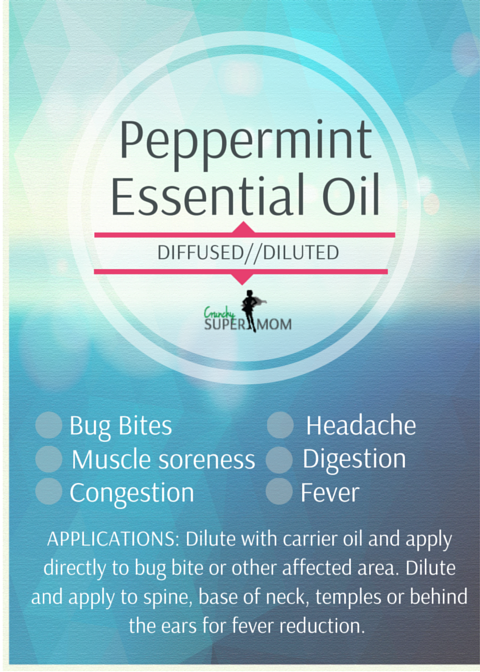Peppermint Essential Oil: Versatile, But Is It Safe for the Whole Family?

Peppermint essential oil has an incredible range of uses so we love keeping it on hand. It can alleviate a headache when applied to the temples and it can lessen nausea when inhaled. However, the high levels of menthol found in the oil make it one to be used with caution.
Peppermint Essential Oil Topical Use
Peppermint essential oil is actually a "hot" oil despite its cooling effects. This means it will burn skin and mucus membranes if it is applied "neat" (without dilution). It is wise to determine the appropriate dilution rate of peppermint essential oil in a carrier oil like fractionated coconut oil , argan oil, or jojoba oil before applying to the skin. Even inhaling the oil straight from the bottle can burn the eyes when the peppermint begins to diffuse into the air.
Applying peppermint oil can reduce body temperature (hence the attribution of the cooling effect). Some studies suggest it can decrease it from 0.1 to 1.0 degrees Fahrenheit. To do this, dilute the peppermint in a carrier oil and then apply the mixture along the spine, the back of the neck and possibly the temples. Knowing that even the vapors of the oil can burn the eyes of a child, it would be best to start only on the spine.
Other topical uses include bug bites, muscle soreness, and sinus congestion. In all of these situations, use a carrier oil and apply directly to the affected area. (Be mindful of your eyes and nose when using for sinus congestion).
Peppermint Oil for Digestion
Scientific evidence supports the use of peppermint to combat viruses and fungi. The research showed how the use of peppermint oil prevented the replication of a virus--which is what allows the virus to thrive. In Europe, peppermint oil is added to medications to alleviate symptoms associated with irritable bowel syndrome (IBS). While there is evidence of the internal use of peppermint oil being effective, topically applying the oil to the stomach will not have the same effect as drinking the tea. Additionally, the therapeutic use of any essential oil internally is not advised unless under the care of a qualified aromatherapist or medical practitioner. Using peppermint herb can be just as effective, or perhaps even more so, than taking the oil internally and is generally considered safer.
Peppermint Oil and Breastfeeding
While little can be scientifically proven, some women say that peppermint has diminished their breastmilk supply. Some state that the leaves of mint alone can reduce a mother's breastmilk supply, while others don’t see ill effects from any type of peppermint, either the herb or essential oil. However, for breastfeeding mothers who are concerned about low supply, it is wise to use caution at least until a healthy level of milk supply has been established. It could be that it is the high level of menthol that peppermint contains is what effects some women. Tisserand and Young (2013) mention in their book that certain individuals are incapable of properly metabolizing menthol so it would be very interesting to see if this relates to breastmilk supply.
Dosing and Application of Peppermint Essential Oil
Always consider the risks and benefits of using essential oils with children. It is advised that Peppermint essential oil should not be used near children under the age of 3--this includes inhalation and diffusion. Children with known or unknown respiratory problems are especially at risk of ill effects of using peppermint oil. The menthol in the oil can slow respiration to the point of asphyxiation in extreme cases. If using topically, make sure to check out the safe levels of dilution on this essential oil dilution chart.
Buying & Using Peppermint Essential Oil
- Plant Therapy and Nature's Gift both have an affordable, sustainable and pure peppermint essential oil.
- Avoid using on or near children age 3 and under
- Avoid/use sparingly when breastfeeding as it is an antigalactagogue
- Apply with a carrier oil to the temples for a headache
- Apply with a carrier oil to the sinus cavities for congestion
- Apply neat or with minimal carrier oil for bug bites
- Apply with a carrier oil to the spine and back of the neck to reduce a fever
- Consider internal use with the oil inside a capsule under professional supervision only
- Try mint tea or fresh mint leaves for nausea or digestive ailments instead of essential oils not just for safety but for affordability.
Get access to our Remedy Cards, like this one. Click here.

References:
Antifungal Activity of Six Plant Essential Oils: http://www.doiserbia.nb.rs/img/doi/1820-3949/2014/1820-39491404291D.pdf
Peppermint Safety Info: http://www.naha.org/naha-blog/peppermint-safety-info/
Join the LIVE coaching community and Productively Present Program™
Get a FREE Productivity Tool Sheet and my weekly newsletter
Join our mailing list to receive the latest news and updates from our team.
Don't worry, your information will not be shared.
We hate SPAM. We will never sell your information, for any reason.

